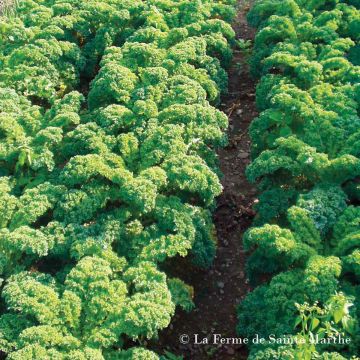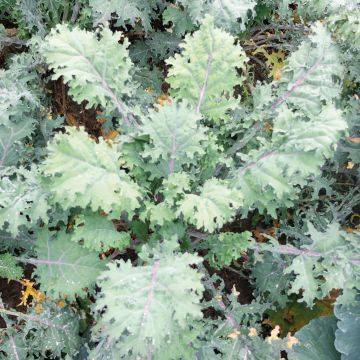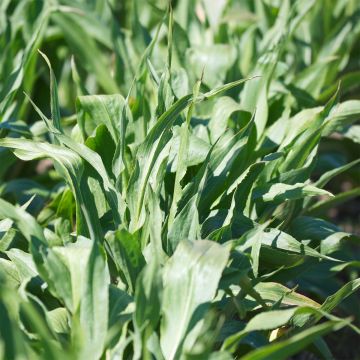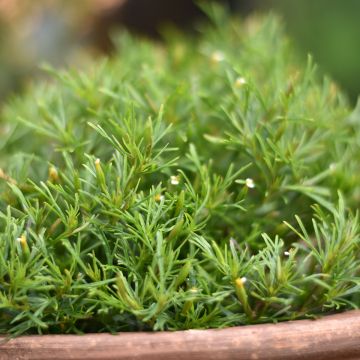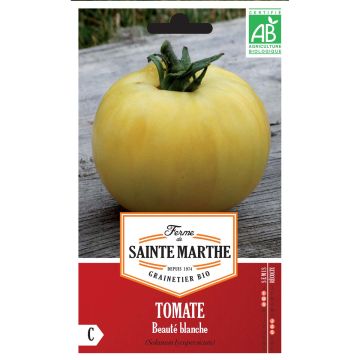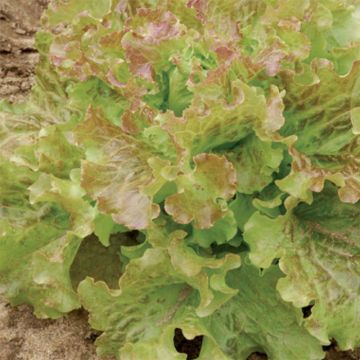

Kale Dwarf Green Curled - Brassica oleracea acephala
Kale Dwarf Green Curled - Brassica oleracea acephala
Brassica oleracea acephala Dwarf Green Curled
Kale, Borecole
No opinions, failed sowing.
Evelyne T., 20/11/2018
This item cannot be shipped to the selected country
Dispatch by letter from €3.90
Delivery to Corse prohibited
More information
Dispatch by letter from €3.90
Delivery to Corse prohibited
More information
Schedule delivery date,
and select date in basket
This plant carries a 6 months recovery warranty
More information
We guarantee the quality of our plants for a full growing cycle, and will replace at our expense any plant that fails to recover under normal climatic and planting conditions.
Seed-only orders are dispatched by sealed envelope. The delivery charge for seed-only orders is €3.90.
Delivery to Corse prohibited: UE law prohibits the import of this plant from mainland France to Corse as part of the fight against Xylella fastidiosa. Please accept our sincere apologies.
More information

Description
The Kale Dwarf Green Curled is a dwarf variety that is exceptionally hardy and thrives in difficult growing conditions. It produces beautiful dark green curled leaves of excellent nutritional quality. Sow from March to May for a harvest 50 to 65 days later.
Kale ("Kayle") is an ancient green cabbage with exceptional nutritional values: it contains more vitamin C than an orange and more calcium than a glass of milk. Low in calories, rich in minerals, and detoxifying, this cabbage, still relatively unknown in Europe, is gaining popularity in our kitchens.
Also known as Borecole, Rabbit Cabbage, or Cow Cabbage, this true nutritional phenomenon has tough curly foliage ranging from green to dark red. It does not form a head. It belongs to the large family of Brassicaceae (formerly Cruciferae) and has the Latin name Brassica oleracea acephala.
Once common on medieval tables and relegated to fodder cabbage, Kale has experienced a spectacular resurgence. It can be eaten raw in salads or quickly steamed and prepared in various ways: quickly sautéed, in gratins, quiches, purées... This "Superfood" can also be incorporated into various preparations such as fruit smoothies. And if you're lacking inspiration, several recipe books are dedicated solely to this particular cabbage.
Kale is easy to grow as it requires little space and is exceptionally hardy (at least -10°C). It also seems to be more resistant to potential pest attacks. However, it requires excellent organic fertilisation and regular moisture, like almost all cabbages.
Harvest: It is done with a knife by removing the leaves from the outer edge of the plant, which will continue to grow and produce new leaves. Kale can be harvested from the young leaf stage until it reaches maturity.
Storage: This cabbage can be stored in the refrigerator for a few days, but since it would be a shame to miss out on its vitamins, we recommend consuming it quickly after harvesting. It freezes well after being blanched for 3 minutes in salted boiling water.
Gardening tip: To reduce the need for watering, we recommend mulching the soil with thin successive layers of grass clippings, preferably mixed with dead leaves, starting from late May. This protective layer helps the soil retain moisture and also reduces weed growth.
Harvest
Plant habit
Foliage
Botanical data
Brassica
oleracea
acephala Dwarf Green Curled
Brassicaceae
Kale, Borecole
Cultivar or hybrid
Annual
Other Kale seeds
Planting and care
The germination temperature of Dwarf Green Curled Kale is between 7 and 29° and takes 4 to 7 days.
Sow from March to May for a harvest 50 to 65 days later.
You can either sow directly in place or prepare young plants that will later be planted in their final position in the garden.
Preparing young plants: Under heated shelter from late autumn to late winter or in a cold greenhouse or nursery in the garden for the rest of the year, sow Kale seeds at a depth of 1 cm (0in) in good seed compost. Lightly cover with compost or vermiculite. Remember to keep the substrate moist but not waterlogged!
When the young plants appear strong enough to handle, transplant them into pots if necessary and, for sowings under heated shelter, gradually acclimatise them to cooler temperatures before transplanting them into the garden when there is no longer any risk of frost.
Direct sowing: In well-amended and finely worked soil, make furrows 1 cm (0in) deep, spaced 20/25 cm (8/10in) apart. Sow the seeds and cover them with a thin layer of fine soil. When the seedlings are well-developed, thin them out, leaving one plant every 40 cm (16in) or so.
Cultivation:
Kale is grown in full sun or partial shade. It is a nutrient-demanding vegetable that requires well-rotted, nitrogen- and potash-rich soil. Preferably in autumn, apply a generous amount of mature compost (around 3/4 kg per m2) by digging it in to a depth of 5 cm (2in), after having thoroughly loosened the soil, as is necessary for all vegetable crops. It is not very tolerant of soil pH, which should be between 5.6 and 6.5. In acidic soil, it will be necessary to gradually raise the pH by adding calcium in the form of Dolomite or Lime.
Kale is beneficially associated with many vegetables such as tomatoes, lettuce... But avoid planting it near other Brassicas, as well as zucchini, fennel, lamb's lettuce, leek, and strawberry.
Seedlings
Care
Intended location
-
, onOrder confirmed
Reply from on Promesse de fleurs
Vegetable seeds
Haven't found what you were looking for?
Hardiness is the lowest winter temperature a plant can endure without suffering serious damage or even dying. However, hardiness is affected by location (a sheltered area, such as a patio), protection (winter cover) and soil type (hardiness is improved by well-drained soil).

Photo Sharing Terms & Conditions
In order to encourage gardeners to interact and share their experiences, Promesse de fleurs offers various media enabling content to be uploaded onto its Site - in particular via the ‘Photo sharing’ module.
The User agrees to refrain from:
- Posting any content that is illegal, prejudicial, insulting, racist, inciteful to hatred, revisionist, contrary to public decency, that infringes on privacy or on the privacy rights of third parties, in particular the publicity rights of persons and goods, intellectual property rights, or the right to privacy.
- Submitting content on behalf of a third party;
- Impersonate the identity of a third party and/or publish any personal information about a third party;
In general, the User undertakes to refrain from any unethical behaviour.
All Content (in particular text, comments, files, images, photos, videos, creative works, etc.), which may be subject to property or intellectual property rights, image or other private rights, shall remain the property of the User, subject to the limited rights granted by the terms of the licence granted by Promesse de fleurs as stated below. Users are at liberty to publish or not to publish such Content on the Site, notably via the ‘Photo Sharing’ facility, and accept that this Content shall be made public and freely accessible, notably on the Internet.
Users further acknowledge, undertake to have ,and guarantee that they hold all necessary rights and permissions to publish such material on the Site, in particular with regard to the legislation in force pertaining to any privacy, property, intellectual property, image, or contractual rights, or rights of any other nature. By publishing such Content on the Site, Users acknowledge accepting full liability as publishers of the Content within the meaning of the law, and grant Promesse de fleurs, free of charge, an inclusive, worldwide licence for the said Content for the entire duration of its publication, including all reproduction, representation, up/downloading, displaying, performing, transmission, and storage rights.
Users also grant permission for their name to be linked to the Content and accept that this link may not always be made available.
By engaging in posting material, Users consent to their Content becoming automatically accessible on the Internet, in particular on other sites and/or blogs and/or web pages of the Promesse de fleurs site, including in particular social pages and the Promesse de fleurs catalogue.
Users may secure the removal of entrusted content free of charge by issuing a simple request via our contact form.



































